There are many crucial lessons for 1st graders, but mastering place value stands out as a key concept for their mathematical success. To aid in this learning, place value games for 1st grade can be an effective tool.
These games help clarify that the position of each digit in a number determines its value, a concept that might seem simple to adults but can be quite perplexing for young children. The digit 3, for example, has a completely different value in the number 143 than in the number 341. Understanding this fundamental principle is crucial for young learners as it lays the groundwork for all future arithmetic operations.
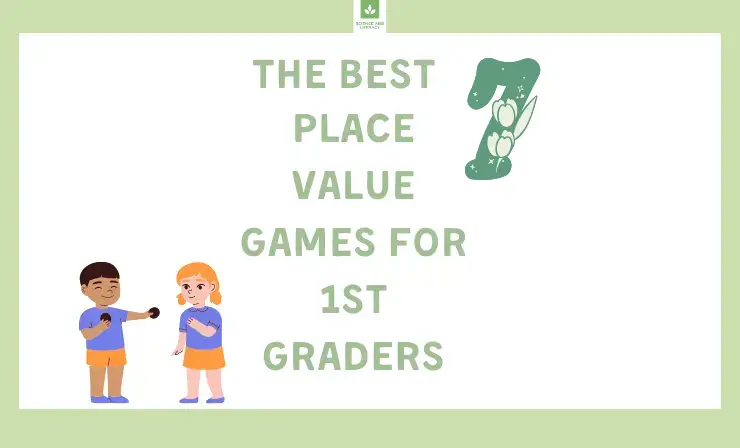
Math has always been one of my favorite subjects to teach. However, when I moved from the upper grades to become a first-grade teacher, I had a hard time helping some of my students understand place value. Fortunately, after some discussions with my teammates, some research, and some experimentation, I was able to discover some different strategies that really helped my students. These strategies not only made my students more confident in their math skills but also made the learning process much more enjoyable for them.
Playing our new place value game by using digits in tens and one’s place! pic.twitter.com/1bqVD6q5WN
— Jennifer Fogle (@MsFogle) March 1, 2023
I think the strategies and games that I’ve found and had success with will also help your students, and I’d love to share them with you! Keep reading, and I’ll share:
- My favorite 7 place value games for first grade →
- How to teach place value to first-graders →
- An introduction to place value →
7 Tens and Ones Games for Grade 1
These place value games for 1st grade are certain to have your students excited and ready to learn and practice place value concepts.
1. Scoop & Group
This hands-on game is designed to help students practice putting items together in groups of 10. It aims to enhance their understanding of basic mathematical concepts and improve their skills in counting and grouping, making learning both engaging and educational.
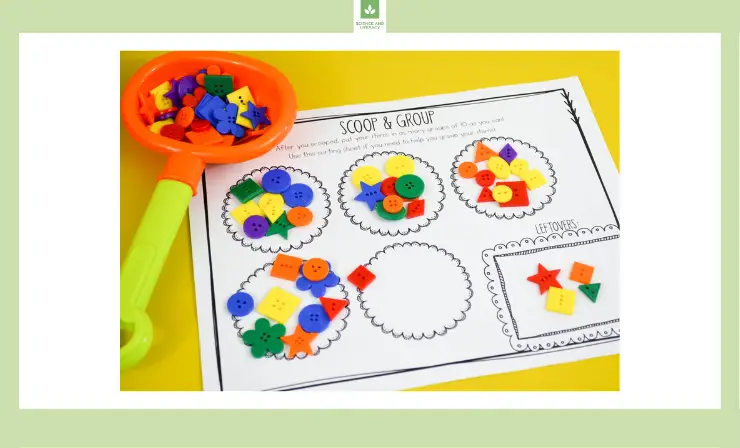
You’ll Need:
- Scoop & Group Recording Sheet
- Small shovel or scoop
- Buttons or other small counters
Each student will need a small scoop to pull some of the counters out of the bag/bin. As they work, they should focus on accurately grouping their items into sets of 10, placing each set in one of the circles on the page designed for this purpose. Any leftovers (for example, the 8 extras if the student scooped out 38) go in the leftovers box. This encourages a hands-on approach to learning, allowing students to physically manipulate the items to better understand the concept of grouping.
Students can then compare the number of counters they pulled out with how many their partner pulled out, and leaving them laid out on the recording sheet will make it easier for students to see which number is greater.
If you’re looking for a good activity for students to practice at home, consider recording this lesson. You can share it with parents so they can recreate it at home to help their children practice making tens.
2. Place Value House
This video activity, designed to complement the hands-on game, can help students learn more about place value, enriching their understanding of how numbers are structured and enhancing their ability to work with larger quantities effectively.
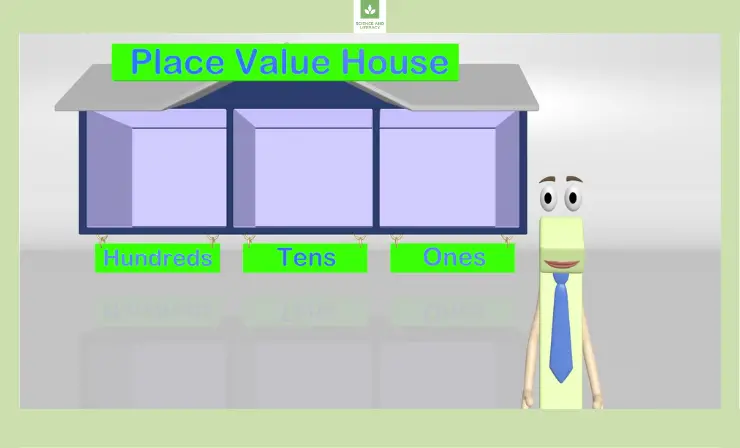
You’ll Need:
- Place Value House Video
- Place Value House tens and ones mats
- Tens and ones blocks
- 2-digit number cards
Project the video for the whole class to see on your interactive whiteboard. Learn more about the best interactive whiteboards here. Make a paper “place value house” for students so they can follow along with the video and practice placing each digit in the right room of their house. This hands-on activity helps solidify the concept of place value in a visual and interactive way. After watching the video, provide the students with additional practice problems they can solve using their place value house mats.
For example, you may give them 2-digit number cards (such as 67 or 19), and they’ll need to decide where to place each digit in the house, fostering a deeper understanding of numerical values and their positions. You could also give them tens and ones blocks and ask them to show a certain number with the blocks, further reinforcing the concept of place value through tactile learning. Then, they should write down the number they showed, allowing them to connect the physical activity with written mathematics.
3. Online Place Value Practice
In today’s digital age, integrating technology into the classroom offers a dynamic way to enhance learning and engagement, especially in mathematics, making it more interactive and accessible. Below, we delve into an innovative approach to teaching place value, utilizing online tools and hands-on materials to create a multifaceted learning experience for students, ensuring they grasp fundamental concepts effectively.
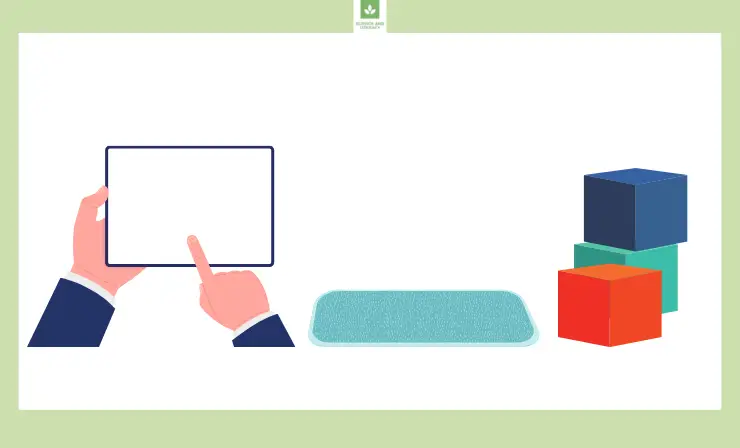
You’ll Need:
- Computers or tablets for each student
- Place value mats and blocks for support
Scroll to the bottom of this page that walks through different ideas you can use to teach place value to your students to find the online review game. For this game, students will need to answer questions about how many digits are in a given number and other related place value questions.
If they choose the wrong answer, the game will pause to display the correct answer, providing an instant feedback mechanism that enhances the learning experience. Furthermore, this interactive format encourages students to engage actively with the material, making the process of learning about place value both fun and educational.
You could use these opportunities as a teachable moment to note what students are missing and provide them with additional practice, thereby personalizing their learning journey and addressing gaps in understanding promptly, ensuring a thorough comprehension of place value.
Great fun playing Place Value games on the computer! Excellent engagement and some super maths! pic.twitter.com/eUQUbLRdCL
— Miss Wills (@misswillspont) September 7, 2021
The video provides instructions for creating a math working model designed to teach children about place value. It’s a helpful resource for making the concept easier to understand.
4. The Three Little Pigs Place Value Game
Dive into a hands-on mathematics lesson that combines storytelling with numerical understanding, using the classic tale of the Three Little Pigs as a foundation for exploring place value. In this engaging activity, students will employ ones, tens, and hundreds of blocks to construct a house for the pigs, translating a 3-digit number into a creative and tangible learning experience.
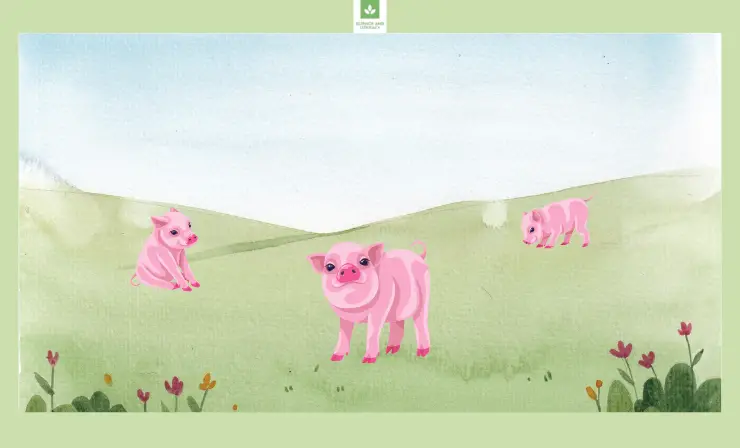
You’ll Need:
- A Three Little Pigs Story
- Ones, tens, and hundreds blocks-both real manipulatives and paper print-outs
- Place value mat
- Construction paper
- Glue
After reading the story of the Three Little Pigs, tell students that they are going to make a house for the pigs using ones, tens, and hundreds of blocks. Give each student a 3-digit number (with just 1 in the hundreds place), and ask them to pull out the number of ones, tens, and hundreds blocks in their number. Students can then use their blocks to make a house for the pigs. After the houses are made, students can glue the paper place value blocks to the construction paper to show the house they created.
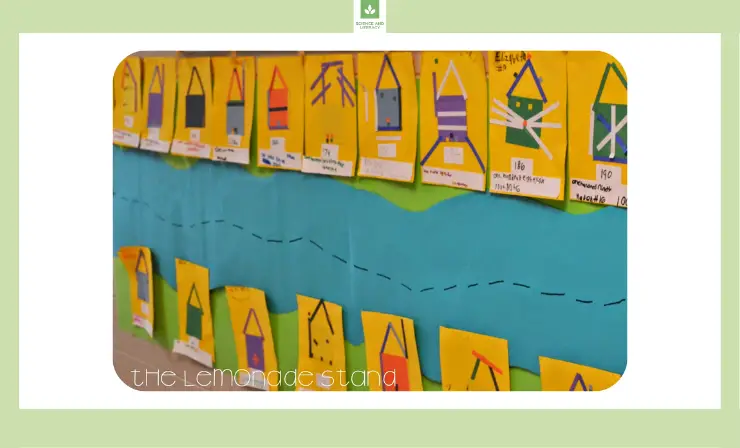
You can discuss with students what numbers they represented at the value of each digit. Students can share their houses with the rest of the class using the document camera (check out our article for a guide to the best document cameras.)
5. The Value of a Name
Introduce your students to a novel and personal approach to understanding place value with an activity that involves spelling out their names using tens and ones blocks. This creative task not only reinforces the concept of grouping and regrouping but also adds a personalized touch to learning mathematics, making the abstract concepts of tens, ones, and hundreds tangible and relatable.
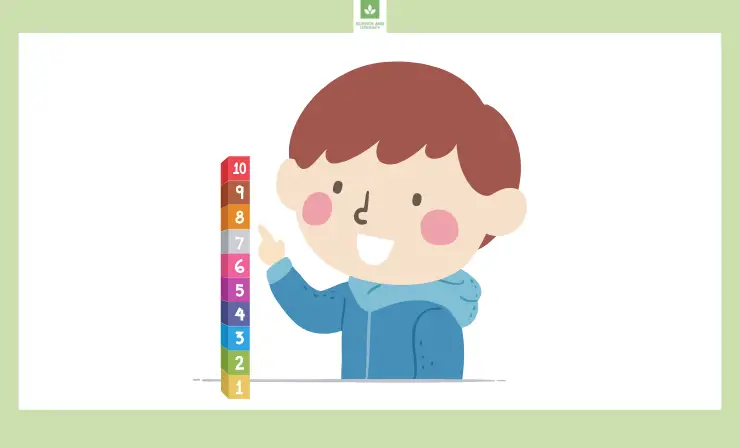
You’ll Need:
- Tens and ones blocks
- Place value chart
Tell students to use the ones and tens blocks to write out their names. After students have written out their names, have them move the ones and tens blocks to the place value chart. They will then need to make groups of 10 ones as necessary to make tens and make groups of 10 tens as needed to make hundreds. Once students have completed these tasks, they will be able to determine the value of their name.
You can have students write out the value of their name by filling in something like: “My name is _______. I have ____ hundreds, ____ tens, and ____ ones in my name.”Consider taking a picture of each student’s name after they make it with the blocks and displaying it with the paper where they wrote their name’s value. It could make a nice bulletin board display.
You can also try playing the game “Guess my number.” For more information, watch the video below.
6. Paper Folding Place Value Activity
This educational activity involves creating a snake out of cardboard to help children learn about place values in an engaging, interactive, and visually stimulating way.
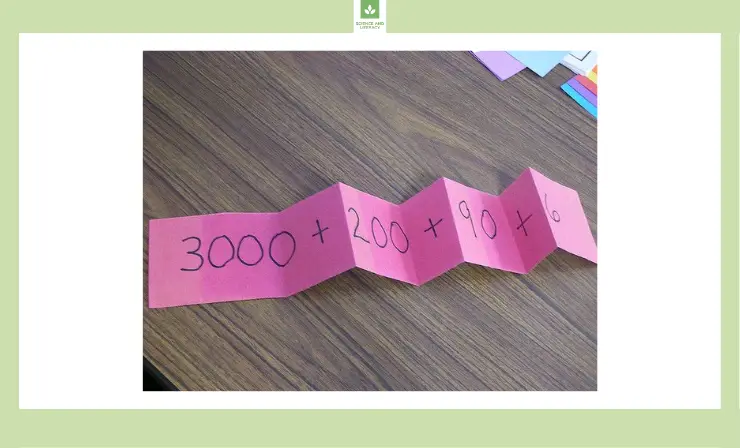
You’ll Need:
- A strip of cardboard or thick paper
- A marker
- Optional: Additional craft supplies such as googly eyes, colored paper, glue, scissors, and paint or markers for decorating and adding lifelike features to make the snake resemble a real one more closely, thus capturing the interest of children even further.
By using just a strip of paper and a marker, educators or parents can draw segments on the snake to represent different place values, such as units, tens, hundreds, etc. For added appeal, especially for younger learners, embellishing the snake with features that mimic real snakes—such as eyes, scales, and a tongue—can make the learning process more enjoyable and relatable.
This hands-on approach not only aids in understanding mathematical concepts but also encourages creativity and fine motor skills development. Adding realistic details enhances the visual appeal, making the abstract concept of place values more concrete, relatable, and understandable for children.
Don’t miss the following video tutorial to see how you can easily create your own place value snake for this activity, making learning both fun and interactive for kids!
7. Place Value Toss Game
Dive into a playful and educational math game designed to reinforce the concepts of place value and the base-ten number system, while also offering a fun way for students to practice comparing whole numbers and using tally marks.
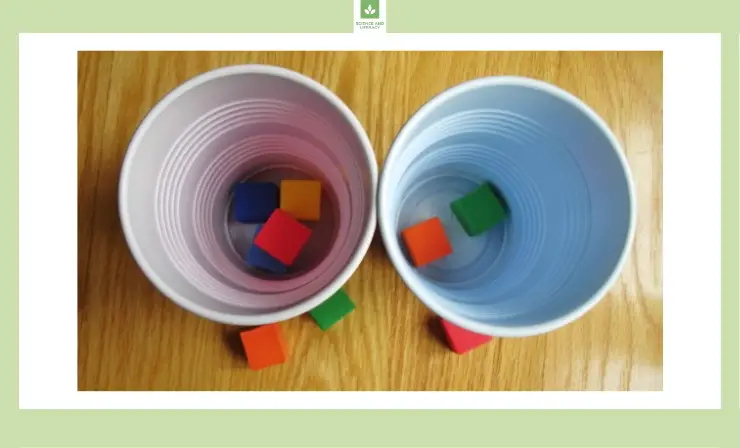
You’ll Need:
- Large paper or plastic cups
- Small objects such as foam shapes
- Paper
- Pencil
- Painter’s tape (optional)
- Marker
In this engaging math game, students pair up to compare whole numbers and practice using tally marks. Using labeled cups for “TENS” and “ONES,” players take turns tossing small foam shapes into the cups from a set distance. After each turn, they calculate their score based on the arrangement of shapes in the cups, announcing it as a combination of tens and ones.
The game continues over ten rounds, with each player aiming to score the highest number. The use of tally marks to keep score adds an extra layer of learning. Variations include adding a “HUNDREDS” cup for advanced learners or increasing the number of shapes to incorporate regrouping skills, making the game adaptable to different learning levels.
Check out this engaging video tutorial to learn how to set up and play the toss game for teaching place value, making math learning not only interactive but also incredibly enjoyable for children. This step-by-step guide will ensure you have all the knowledge needed to bring this educational activity to life in your classroom or at home!
How To Teach Place Value to First Grade Students
Ok, so now that I’ve shared some of my favorite tens and ones games for grade 1, let’s step back just for a second and talk about how to teach place value to students. The games above can be used while teaching the concepts in a small group or as independent practice once students have had enough instruction on the concept to be ready to play on their own or with a partner.
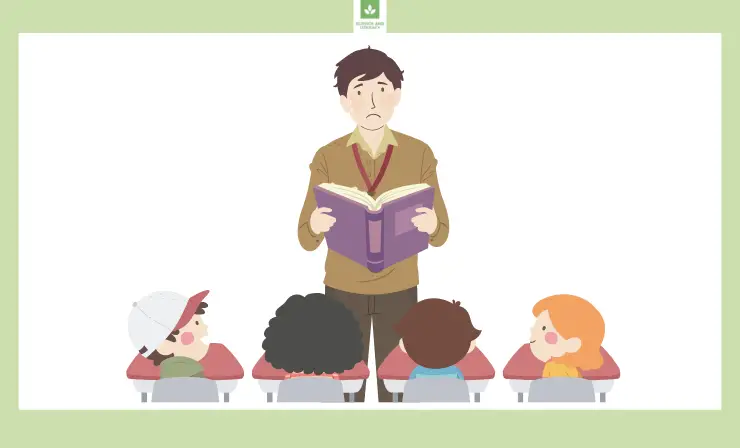
The best way to teach place value to students is to use a lot of manipulatives. Students need to practice building a ten using 10 ones and building a hundred using 10 tens. With repeated practice, they’ll start to see the relationship between ones, tens, and hundreds.
As you’re introducing the concept of place value and want students to learn how to make tens and hundreds, this place value song may be helpful.
Here are a few other tips to help you teach place value to your 1st graders:
- Have students draw pictorial ones, tens, and hundreds of models to go along with the physical manipulatives.
- Use ten frames to help students visualize how many ones make a ten.
- When reading numbers, have students read the number in both standard form and base ten form (for example, 57 should be read as fifty-seven and 5 tens and 7 ones).
- Create a daily place value warm-up to help students practice.
- Have students guess your ‘mystery’ number by describing it. For example, “my number is 4 tens, 8 hundreds, and 2 ones”. You could even make this more challenging when your students are ready by saying, “My number has 4 tens, an odd number in the hundreds place, and an even number in the ones place” (there could be multiple correct answers for this riddle).
- Look for additional place value lesson plans online to supplement your instruction, such as this Place Value Party lesson idea.
If you’d like some additional tips on how to teach place value to first-graders, this video is an excellent resource. It includes directions for the place value game Race to 100 (or Race to 50), the What’s My Value game, and the Zoey Zoo Fiasco math mystery place value game.
I don’t know about you, but I find these videos by teacher Susan Jones to be very informative and easy to understand. I also like how clearly she lays out the directions for each of her place value games and find that they are easy to replicate with my students.
Introduction To Place Value
Before you teach place value to your 1st graders, it is important to make sure you have a solid understanding of what place value means.
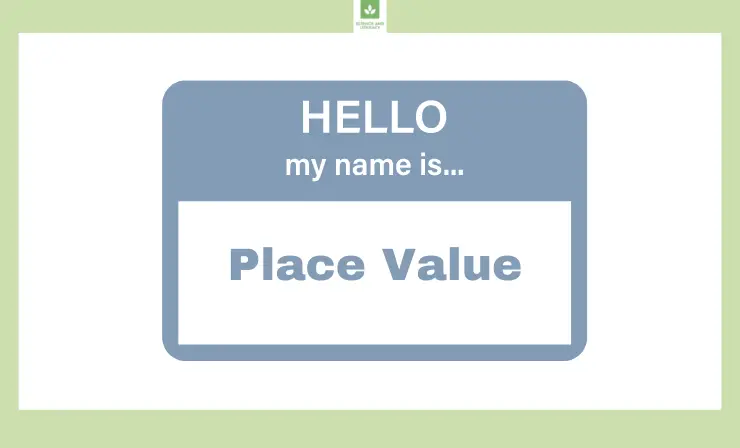
So, what exactly does place value mean? Place value refers to the fact that a digit’s value in a number is dependent on its position in a number. When we refer to numbers, each digit has its own place. 1st graders primarily work with two- or three-digit numbers, so let’s look at examples with those.
In the 2-digit number 34, the 3 is in the ten’s place and the 4 is in the one’s place.3 in the tens place does not have a value of only 3. Rather, it means 3 tens, which has a value of 30 (10, 20, 30). The 4 in the ones place simply means 4 ones (1, 2, 3, 4), so its value is just 4.
30 + 4 = 34
Now, for a 3-digit example. In the number 347, the 3 is in the hundred’s place, the 4 is in the ten’s place, and the 7 is in the one’s place. The value of a 3 in the hundreds place is 300 (count by 100 three times: 100, 200, 300). The value of the 4 in the tens place is 40 (count by 10 four times: 10, 20, 30, 40). Finally, the value of the 7 in the ones place is 7 (count by 1 seven times: 1, 2, 3, 4, 5, 6, 7).
300 + 40 + 7 = 347
If you look more closely at both of those examples, you’ll notice that each number had a 3 and a 4 in it. However, since these digits were in a different place in each number, they did not have the same value. In the first number, 34, 3 was in the ten’s place with a value of 30, while in the second number, it was in the hundred’s place with a value of 300.
This video shares a short activity that you can do with your students to help them see how the value of each digit changes based on its place in a number. The example in the video is for much longer numbers, but you could easily modify it to use either 2- or 3-digit numbers.
Do you think this activity will help your students understand how a number’s place determines its value?
Useful Resources
- How to Teach Kids Numbers: 10 Ideas for Parents
- 1st Grade Math Skills, What Your Child Will Learn, Komodo Math
- Tips for Teaching Elementary Math
Final Thoughts
Helping your 1st-grade students develop a deep understanding of place value is one of your most important jobs. However, with the place value games for 1st grade that I shared above, it doesn’t have to be boring or tedious to help them gain this essential knowledge. Which games are you ready to begin incorporating into your lesson plans right away?
For more student games, explore our article on time games that can assist your class in practicing and reviewing how to tell time.
- 14 Science Experiments for Middle School — Unlock the Wonders of The World in Your Classroom - February 18, 2023
- Top 11 Sound and Voice Amplifier Apps: Enhance Audio on Your Device with the Best Volume Boosters - January 26, 2023
- 7 Creative Valentine’s Day Poster Ideas to Make Your Space Feel More Festive - January 11, 2023

My daughter is in 1st grade and I still don’t know how to make it easier for her to understand the meaning of the place of value. Do you know of any simple explanation?
Take as an example the number 123. Here the 3 is just 3. The 2 represents 20 (or two tens), and the 1 represents 100. Their values depend on where they appear in the representation of the number. That’s place value.